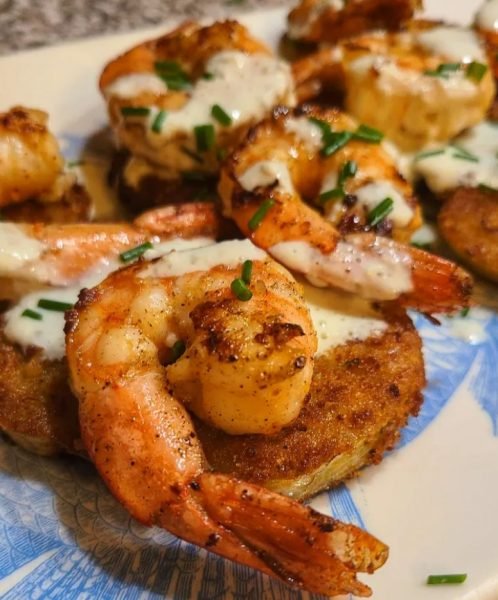You’ll Need
Spicy Feta Sauce
1/2 cup crumbled Feta cheese
1/2 cup strained full-fat yogurt
2 Tbsp. red wine vinegar
2 – 4 Tbsp. minced roasted hot pepper (jarred is fine)
2-3 Tbsp. extra virgin olive oil
cream as needed
Fried Green Tomatoes
2 medium sized green tomatoes, cut into 1/2 inch slices
1 tsp. salt
1/2 tsp pepper
1/2 cup all-purpose flour
2 eggs, lightly beaten
1 cup seasoned bread crumbs (bought at grocery stores)
vegetable oil for frying
Shrimp
16 medium shrimp, peeled and deveined, tails on
2 Tbsp. extra virgin olive oil
2 cloves garlic, minced
1/4 cup chopped fresh parsley
1/2 tsp. sea salt
pinch of chilli flakes
lemon wedges
2 Tbsp. chopped chives for garnish
For the spicy Feta sauce, crumble Feta in a medium bowl then mash with a fork, add yogurt, vinegar, peppers and olive and stir to combine. Add cream if you want a sauce consistency. Adjust flavours to your taste, set aside.
Pre-heat oven to 200F.
Place your shrimp in a bowl with olive oil, garlic, parsley, salt and chilli flakes and toss to mix. Reserve.
Season your tomato slices with salt and pepper. Set up dredging station (one bowl with flour, one bowl with beaten eggs, one bowl with bread crumbs). Place about 1/4 inch oil in a large skillet and heat to medium.
While the oil is heating, dip your tomatoes in flour, egg then breadcrumbs. Working in batches, fry tomatoes for 1-2 minutes a side or until golden brown. Place fried green tomatoes in pre-heated oven to keep warm.
Discard the oil from the pan you used to fry the tomatoes, wipe clean with paper towel. Place the skillet on your stove-top over medium-high heat.
Add half the shrimp, saute for 1 to 1/2 minutes flip saute other side until pink. Transfer to a plate, repeat with second batch.
To assemble, arrange fried green tomatoes on one or two platters. Place shrimp on tip, drizzle spicy Feta sauce on top and garnish with chives and serve with lemon wedges.
Pro Tip: When cooking shrimp, they can go from plump and juicy to tough and rubbery very quickly. Shrimp cooking times can vary according to size. As a rule of thumb – when your shrimp curls up to form a C (both sides) then it’s cooked. If the shrimp forms an O then it’s overcooked. Watch your shrimp when cooking.

